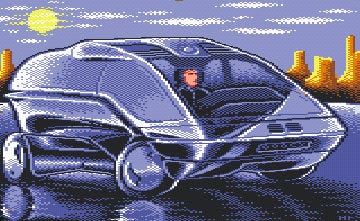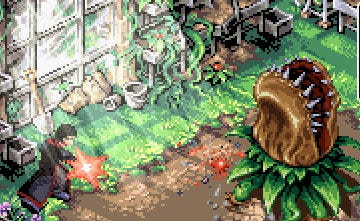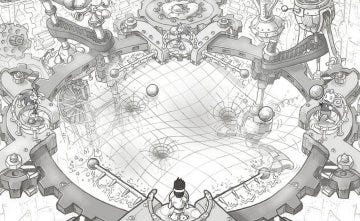This article was originally published on Coregamers on January 3rd, 2008.
Part I
From anonymity to renown
Henk Nieborg is one of the premier names in European pixel art. His work bears with it a distinct hallmark, a peculiar taste for detail in form and animation. For years, he refined his technique using a Commodore C64 software named KOALA-PAINTER, a tool that had a profound impact over his life. Later, he would regret having to part ways with this computer in order to upgrade to the then sensationally new Amiga 500. Over the years, his bitmap design technique progressed by leaps and bounds and it wouldn’t be long until this small hobby entertained during idle became a vehicle for his unique artistic vision.

Nieborg’s introduction to the videogame world was the product of mere happenstance. During a summer holiday visit with friends in 1990, he had the opportunity to make Erwin Kloibhofer’s acquaintance, an Austrian programmer with whom he would team up for more than half a decade. That same year, he began producing his first serious project, GHOST BATTLE, a cheeky and admitted reproduction of CAPCOM’s GHOSTS ‘N GOBLINS, a concept that the two young men were nevertheless able to sell to Thalion, a small German software company founded by Holger Flöttmann and Eric Simon. Their next project, LIONHEART, went on to become one of Amiga’s elite visual showpieces on account of its high-resolution graphics, parallax scrolling and color gamut, designed and animated over the course of an entire year. The popularity of action games and sword-wielding characters, this game singlehandedly prevented the studio from assured bankruptcy in 1993.
Much to the disappointment of the Commodore computer gaming community, Henk and Erwin turned down the offer for a sequel, despite the overwhelming success and acclaim the game received. Not long after, Liverpool-based studio Psygnosis summoned the duo for a job interview, conscious that their combined attributes matched the style most appreciated by their audience.
Part II
Great changes
Aspiring to a never before seen degree of visual detail, MISADVENTURES OF FLINK represented a shift from an amateur to professional game creation, under the auspices of a well established and respected company. The game, originally released on the Mega Drive, would see itself ported to the Mega CD and the Amiga CD 32. Now working in England, Nieborg’s aptitude to create eye-catching visuals stood out as, once again, the judicious choice of palette and careful assembly of parallax scroll layers produced results seldom seen in a game for this format. In his personal website, the Dutch artist states that this was the first project where the entirety of the visuals had been designed by him, representing a major advancement in his career.

While development went smoothly, hitting all deadlines, FLINK was far from successful in part due to the absence of any meaningful investment in marketing. Generally speaking, critics exalted its visual splendor, melodic soundtrack and original twist on the platformer genre, agreeing that it presented enough of a departure from other offerings of its day to be considered. Players, on the other hand, appear to have felt intimidated by its somewhat steep learning curve.
Their following project at Psygnosis allowed the duo to expand on the world of LEMMINGS, undoubtedly one of most successful videogames coming out of the Liverpool studio and, indeed, one of England’s best selling games of the 1990s. Despite its many iterations over the course of the years of its development, THE ADVENTURES OF LOMAX, first released on the Sony Playstation and later for Windows, remains the peak of their individual expression and collaborative power.
Although the game bears a number of similarities to its less successful predecessor, gameplay was overall more fluid and accessible, the result of a longer and less restrictive development process. Equally, the visuals were of an unparalleled fidelity, brimming with buttery smooth animations, at the same time taking advantage of a greater screen resolution. The processing prowess of the Playstation console expanded game mechanics, as seen by its unusually yet bold parallel playing field system, whereby the green-haired lemming can vault to to a distant background layer, producing an impressive visual effect. It stands to this day as one of the most accomplished uses of sprite scaling techniques in that console.
More than any other game of his, LOMAX at once lays his genius and obsessive nature bare in equal amounts, the degree of minutiae of his artwork being such that multiple playthroughs are required for a full appreciation. Nieborg draws and retouches without conscious limitations, as if his work was itself an extension of the venerable Flemish painting school of the renaissance, characterized by exceptional tonal abundance and formal rigor.
After seven years working together, Nieborg parted ways with Kloibhofer, leaving videogame production in favor of pursuing other life interests. He invested some of his earnings in the area of web design, having founded his own online DVD shop, as well as an internet content production company (Tribute), in addition to his own website where he writes, wistfully, of his days as a computer graphics designer. But it would not be long before his love of pixels steered in back to his origins.

Henk Nieborg has reconnected with the game industry in recent years, having joined Eurocom for the adaptation of juvenile films ATLANTIS and HARRY POTTER AND THE CHAMBER OF SECRETS, both released on the Nintendo Gameboy - the perfect outlet for his pixel artwork to live on. He also established PixInSpace, a growing company based in Holland, specializing in different areas of design. Its short resume already includes a variety of concept, character and background art for 2D and 3D videogame projects alike, a testament to Henk’s adaptability and vitality in taking on the challenges of an evolving medium he helped establish. His life’s work translates an ardent passion for design and a particular appreciation for the basic visual component of bitmap graphics and every point of light pervading the screen.
Concept art for the unreleased SEGA TEAM TIME CRYSTALS for the Playstation 2 (source: PixInSpace).
Part III
The voice of experience
COREGAMING : How did you came to work on videogames? Was there a decisive moment leading to it?
HENK NIEBORG : I've always been fond of playing games in any form. Creating videogames seemed so far away so i kept on dreaming. I was just doing school and doing my thing as a kid. It never crossed my mind really till i met programmer Erwin Kloibhofer. Before GHOST BATTLE, I didn't really bother to paint anything on the my Amiga 500 because it was quite scary back then to pixel at the amazing resolution of 320x240. Compared to the C64 that was quite a leap. Anyway, I soon realized that we could do some real cool stuff together. We just started on GHOST BATTLE of what we thought a game like this should look like. I played a lot of games in the arcades like GHOSTS ‘N GHOBLINS from Capcom and Green Beret from Konami and got my inspiration from that. That's all really, It's quite a ride till now looking back on it.
CG : Looking back at GHOST BATTLE, though a brilliant work altogether, one can see how much your work as a graphic artist progressed. How do you feel looking at it now?
It was my first serious title I've worked on. At least that was our idea about it. Looking at GB now it's quite adorable really. It's very obvious I still had a long way to go. But hey, we're talking 1989 almost 20 years ago now. Time flies when you're having fun.
CG : You created four different games in cooperation with Erwin Kloibhofer, so your names have always been closely associated. How did you two meet and how was it like to work with him all those years?
HN : We met very coincidentally through other people really. I got introduced to Erwin when he visited Holland when he kinda took a brake from home. He made a little game called 'charly' which he wanted me to do the title screen for. So I did. Working together with Erwin was the best experience of my life when looking back on my career till now. It was never about money. We just wanted to get the most out of the hardware. Erwin thinks the same because I spoke with him recently. We also never had any commercial thoughts about our talent and games. We just did what was fun. We could have probably gotten some more money out of it but that would have taken away the fun too much. Pretty crazy huh? So crazy that I would do it all over again.
CG : Sifting through my collection of classic magazines I find nothing but the best adjectives when it came to describe the visual quality of LIONHEART. Some even claim it has the best visuals from any Amiga game. What were your greatest influences for the design of both conceptual art and characters?
HN : With LIONHEART I had to draw some stuff which I never drew before so LH was pretty much a learning school for me. I still remember when we saw the demo of SHADOW OF THE BEAST and how impressed I was. When starting with LH we knew that our game also had to have a very impressive beginning. I have to say that Eric Simon at Thalion pretty much inspired and pushed us in that direction to do all these crazy things.
For instance, I checked some books about human anatomy to draw 'Valdyn' for the intro of LIONHEART. I had a few artbooks from Burne Hogarth the first 'Tarzan' artist which I learned from a lot. Looking at the backgrounds and sprites I was pretty much inspired by early work from french artist Vincent Segrelle and of course master Rodney Matthews. While looking at work from all those artists I also realized I had to somehow create my own style which I think I succeeded in doing.
CG : LIONHEART does have many common visual elements with SHADOW OF THE BEAST. Coincidentally, you ended up working with Psygnosis and helped solidify the studio’s powerful visual identity.
HN : The people at Psygnosis were fond of the same artists as I was. Roger Dean, for example: a lot of his original artwork was used for many Psygnosis games. The well known Psynosis owl logo was also designed by him. My style pretty much fitted in quite well because it was inspired by the same people. On a sidenote, we never took BEAST as an example for LH. We looked at other more playable stuff available on the Sega Megadrive / Genesis and SNES library instead.
CG : The world of MISADVENTURES OF FLINK is easily one of the most impressive to be seen in any console at the time. The jaw-dropping backgrounds, the detailed and fluid animations, parallax scrolling… what was it like developing for the Mega Drive? Was it much of a departure from working for the Amiga?
HN : No, not really. It was a step forward when compared to the Amiga. The hardware pretty much was designed for the stuff we wanted to do. Think of hardware sprites, scrolling and flipping etc. You had only had four 16 color palettes out of a total palette of 512 colors on the Megadrive (if i still remember it right). It was a new toy for me really where I wanted to get the most out of. I would have loved to do some more games for the Megadrive but that wasn't possible anymore because we entered the Megadrive market a little too late unfortunately. After FLINK was done I started drawing some Lemming sprites for a new Megadrive game which were used in LOMAX on the Playstation later.
CG : Much like in FLINK, the LOMAX recaptured the platforming structure with luxurious visuals. How did you manage to achieve such great results animating characters? Was there a specific technique or was it simply hand-drawn, hard work?
HN : It's all hard work built on my experience really. I would have done some things different now like the backgrounds had to many tints in the color palette which caused a lot of delays when drawing the backgrounds but the good news is that it turned out quite well. For instance for the Cemetery level in LOMAX took almost 2 months to pixel. Nowadays on NintendoDS I've got tile sets done withing one or two weeks.
It was quite an amazing achievement doing a game like Lomax with just 2 people looking back on it. The one game I'm the most proud of until now. Actually, Lomax’s original name was Sir Lummox. He was one of the four playable characters that would have appeared in the game. The other 3 characters were dropped together with the animated TV-series that was planned to support the release of the game. Lomax has been through quite a few changes, I can tell you.
CG : When working with time constraints, which element do you tend to prioritize the most: the motion and animation or the sheer detail of the drawings?
HN : When you let me loose on graphics someone has to stop me in one way or another. In most cases it's the deadline that does the trick. Otherwise I would just go on forever tweaking the bits and adding more detail. I also learned that adding too much could spoil your work also. Think I found the right balance now. That's also the beauty when creating GFX when working on something and all of a sudden it's there as you imagined it. That moment is truly wonderful.
Coming back to your question, in most of my games I did all the GFX myself which resulted in having a lot of detail in everything. You have to share the workload with projects now because deadlines are really tight nowadays. Especially when handling licensed stuff. As long as the graphics are consistent I have no problems with it. Sometimes it's even not your call to have the final word. Back with LOMAX and my other games it was a different case. So having an original project all for yourself is pretty much a luxury. But it still happens, which is hopeful.
CG : You worked with Erwin for many years. What was it like to work with such a talented programmer? Was there any particular reason why you went on your separate ways?
HN : Like I said before, working together with Erwin was the best experience in videogame development I ever had till now. We just saw each other grow in technical and artistic ways which was very inspiring. In my opinion it could have lasted much longer but after LOMAX I pretty much had a burnout which I didn't realize back then. So we went our own ways. Anyway, I'm playing with a lot of cool thoughts in my head at the moment so I'm hoping to get this feeling back pretty soon really.
CG : Do you still find pleasure in playing videogames today? What were your favorites back in the time when you started doing game graphics?
HN : I absolutely love to play videogames and I still adore the platform genre the most. Only I don't spend as much time on it anymore because I've got a different life now complete with wife and two daughters. When developing all of our games we looked a lot at the Megadrive, PC-Engine and Super Nintendo games. For instance with Lionheart we looked a lot at MICKEY’S MAGICAL QUEST on the Megadrive for playability reasons. This game used dynamic jumping which was never done before so we also used in LH. For FLINK, I was inspired by the Capcom game THREE WONDERS, especially the platform bit which had amazing graphics. With LOMAX, I just used my experience and fantasy to design and create the whole thing. Also another reason why I'm the most proud of this game yet.





